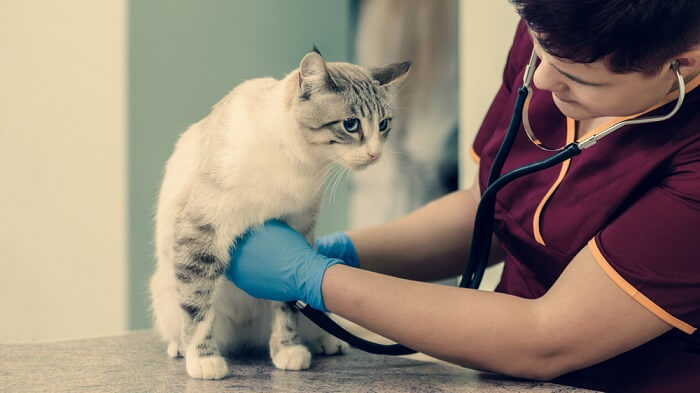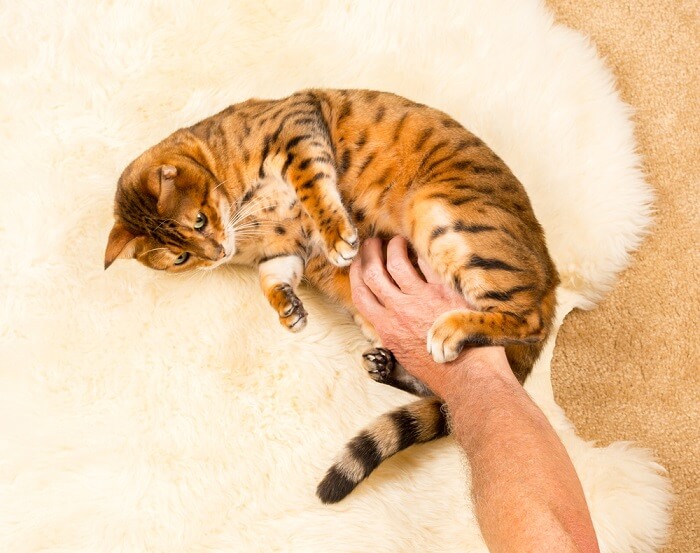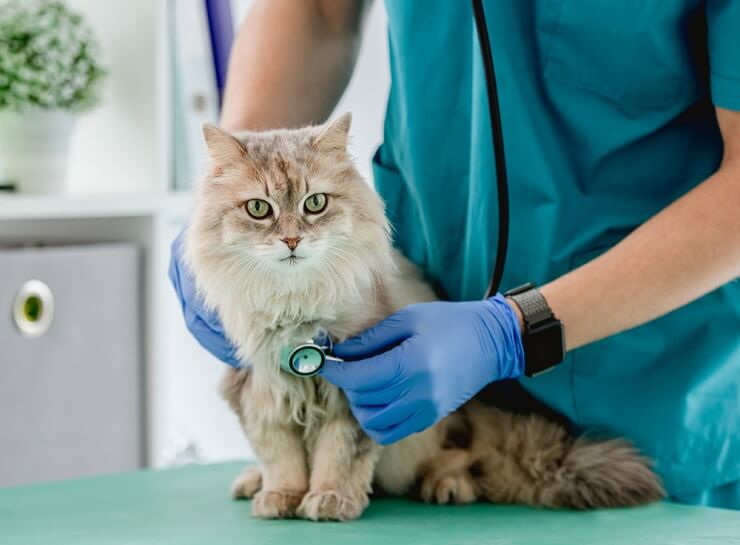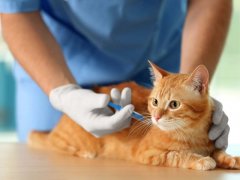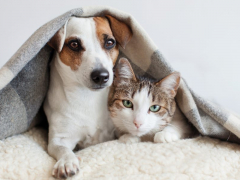You can easily measure your cat’s heart rate, and this can provide important information about your cat’s state of health. Heart rate is one of the key vital signs of a cat’s health, alongside breathing rate and body temperature.
The natural physiology of a cat’s body acts to ensure that the heart produces an appropriate output, matching the body’s needs at any given time.
The heart rate is measured in beats per minute (bpm). If you think of the beeps that a monitoring machine makes in television hospital dramas, that’s usually the heart rate.
Cat Resting Heart Rate
When a cat is resting, the baseline heart rate is low, as the demands of the body are minimal. A cat’s heart rate should be between 80 and 160 when resting at home, but it can be higher than this if a cat is stressed or active.
When a cat starts becoming active or stressed, the heart rate rises, usually along with the breathing rate, to allow more blood to be pumped around the body, more rapidly, providing energy and oxygen to the muscles, and removing waste products, including carbon dioxide from the muscles.
In addition to this physiological variation, if a cat is suffering from various diseases, including heart disease, the heart can beat significantly slower or faster.
Monitoring your cat’s heart rate is a useful way of checking on your cat’s general health. If you record a cat’s vital signs regularly, it can be helpful for your veterinarian. In an emergency situation, measuring the heart rate can help explain in more detail to your veterinarian what’s going on with your pet.
The Different Ranges of a Cat’s Heart Rate
The normal heart rate of a cat is quite variable, depending on a number of factors.
Various studies have examined the normal heart rates of healthy cats. Typically, heart rates ranged from 80 to 160 (averaging 120) in relaxed healthy cats at home moving up to 142 to 222 in normal cats visiting a vet clinic(where they may be mildly stressed).
When measuring heart rate when your cat is calm and relaxed at home, the following ranges apply:
- Low (resting heart rate) – Less than 80 beats per minute
- Normal – Between 80 and 160 beats per minute
- Rapid – More than 160 beats per minute
These rates are not absolute, but they provide a helpful general guide.
How to Check Your Cats Heart Rate
The easiest place to check your cat’s pulse is the femoral artery, which is on the inside of the upper hind leg, close to the abdominal wall.
There are two ways to find your cat’s heart rate.
1. Place your hand on the side of your cat’s chest, with your fingers on the rib cage, and feel the heart beating directly. You should feel the bump-bump of the beating heart, and if your cat has a heart murmur, you may feel a little vibration in between each beat.
2. Learn to take your cat’s pulse, which is generally the same as the heart rate, but measured by feeling a blood vessel with your fingertips. The easiest place to do this is to feel the femoral artery, which is on the inside of the upper hind leg, close to the abdominal wall.
If you press your fingers into the muscles on the inside of the leg, you should feel the gentle intermittent vibration of the pulse. You may have to move your fingers around a few times to find this, and it’s easier on some cats than others.
If you cannot find the pulse, ask your veterinarian to show you the next time you take your cat to the vet clinic for a checkup. The front leg can be used too, but this is more difficult.
In either of the above methods, count the number of beats or pulses in 15 seconds, then multiply this by four to obtain the pulse/heart rate in beats per minute.
Causes of Abnormal Heart Rate in Cats
There are many possible causes of abnormalities in the heart rate, including:
Heart Rate Too Low
Just as you wash your bedding regularly, be mindful of keeping your cat’s favorite blankets/beds cleaned regularly.
If a cat’s heart rate is less than 80 per minute, possible causes include heart disease, debilitating illness and hormonal issues. If your cat’s heart rate is this slow, you should record the heart rate a few times, then book an appointment with your veterinarian for a review.
Heart Rate Too High
If your pet’s heart rate is more than 160 at home, this is on the high side. Possible causes include hyperthyroidism (overactive thyroid gland), heart disease (such as congestive heart failure), high blood pressure and other metabolic illnesses.
Again, record the heart rate on several different occasions, then book an appointment with your veterinarian for a review.
If the heart rate is too high or too low, it’s worth also assessing other aspects of your pet’s vital signs.
Count the respiratory rate. Measure the number of breaths in 15 seconds, and multiply by four.
Take your cat’s temperature. This can be done with by placing the lubricated tip of a digital thermometer (a rectal thermometer) into the cat’s rectum. Click here to learn more about taking your cat’s body temperature.
Treatment of Abnormal Heart Rate in Cats
If your cat is experiencing an abnormal heart rate, your veterinarian will do a complete physical exam, including listening to your cat’s heart.
The first things your veterinarian will do is listen to your cat’s heart rate and carry out a detailed physical examination, checking for other signs of ill health, such as weight loss. If your veterinarian is concerned, he or she may recommend various investigations, such as blood and urine samples, x-rays (radiography), ultrasound and an EKG.
Your vet might consider loaning you a Holter monitor for your cat, a device the cat wears for 24 hours that obtains continual measurements of the heart rate that can be downloaded and analyzed.
It’s easy to learn how to measure your cat’s heart rate, and this can act as a useful additional guide to your pet’s health, as well as providing helpful information you can pass on to your veterinarian.
Frequently Asked Questions
How many times should a cat's heart beat per minute?
Ideally, the heart rate should be between 80 and 160 when a cat is calm and relaxed.
Do cats have a rapid heartbeat?
The normal heart rate of cats is faster than humans, and faster than most dogs. In general, the larger an animal is, the slower is their heart rate.
